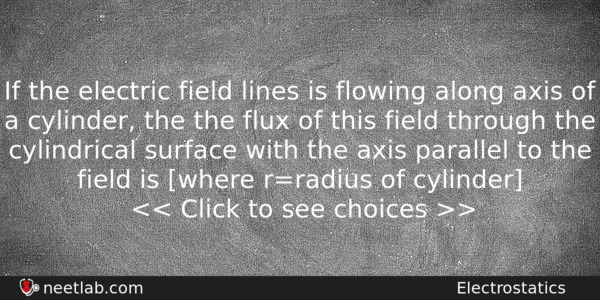| ⇦ | 
| ⇨ |
If the electric field lines is flowing along axis of a cylinder, then the flux of this field through the cylindrical surface with the axis parallel to the field is [where r=radius of cylinder]
Options
(a) σ/2πrε₀
(b) σ/ε₀
(c) zero
(d) σ/2ε₀
Correct Answer:
zero
Explanation:
As we have to find the electric flux through the cylindrical surface and we are given that the electric field is flowing along axis of cylinder.
So as we draw area vector on cylindrical surface it will make an angle of 90• by which the cos 90 will become 0 and ans would be 0
Related Questions: - The minimum wavelength of X-rays emitted by X-ray tube is 0.4125Å
- A body of mass 1.0 kg is falling with an acceleration of 10 ms⁻².
- Ist law of thermadynamics is based on
- If r denotes the distance between sun and the earth, then the angular momentum of the earth
- An ideal black body is equivalent to
Topics: Electrostatics
(146)
Subject: Physics
(2479)
Important MCQs Based on Medical Entrance Examinations To Improve Your NEET Score
- The minimum wavelength of X-rays emitted by X-ray tube is 0.4125Å
- A body of mass 1.0 kg is falling with an acceleration of 10 ms⁻².
- Ist law of thermadynamics is based on
- If r denotes the distance between sun and the earth, then the angular momentum of the earth
- An ideal black body is equivalent to
Topics: Electrostatics (146)
Subject: Physics (2479)
Important MCQs Based on Medical Entrance Examinations To Improve Your NEET Score
18000+ students are using NEETLab to improve their score. What about you?
Solve Previous Year MCQs, Mock Tests, Topicwise Practice Tests, Identify Weak Topics, Formula Flash cards and much more is available in NEETLab Android App to improve your NEET score.
Share this page with your friends

As we have to find the electric flux through the cylindrical surface and we are given that the electric field is flowing along axix of cylinder
So as we draw area vector on cylindrical surface it will make an angle of 90• by which the cos 90 will become 0 and ans would be 0
Thanks (Prateekpreet Madhukar)